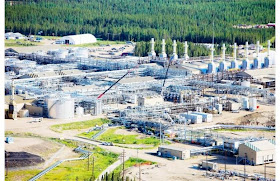Canadian oil sands producers are gradually moving away from the open mining of oil sands. Instead, they are increasingly utilising in situ production methods which leave the land surface features unaltered, and allow access to deeper deposits of bitumen which are not accessible from the surface.
...the mines give way to tidier industrial sites amid boggy greenish-brown muskeg and stands of white spruce, jack pine, and aspen. These forest-ringed facilities have traded shovels and enormous trucks for an extraction process that drills down hundreds of meters into solid ribbons of bitumen and, using vast quantities of steam, melts the tarry petroleum in place. Liquefied bitumen then oozes out through a system of parallel pipes. Such "in situ" extraction operations now account for nearly half the current output of northern Alberta's oil business, and that figure will only increase. Alberta's 1.8 trillion barrels of bitumen may be the world's largest single accumulation of hydrocarbons, but four-fifths of this resource lies deeper than strip-mining can reach.Faux environmentalists, carbon hysterics, and lefty-Luddite dieoff.orgiast greens, will lament the rapid, progressive buildup of oil sands development in Canada. But then, if they could think clearly, they would focus on solving problems rather than whining about their imaginary nightmares.
In situ extraction is expensive—on average, it's not profitable if world oil prices are below $60 per barrel. But with today's prices consistently well above that, the practice is booming. The oil sands will generate over 1.5 million barrels of oil per day this year, according to the Canadian Association of Petroleum Producers, a Calgary-based group. That accounts for more than half the oil that Canada pipes to the United States (Canada is its neighbor's single biggest source of imported oil). By 2025, oil-sands production is projected to more than double, to 3.7 million barrels per day, and in situ operations will deliver nearly two-thirds of that boost.
...the Canadian economy, particularly in Alberta, has become heavily dependent on the growth of the oil-sands industry. Investments from Canadian firms and global oil giants totaled $13 billion in 2010 and grew to $16 billion this year. The oil sands have made Alberta the hottest place in Canada for jobs, investment, and growth, helping the country avoid many of the economic woes afflicting the United States and much of Europe.
The oil sands mean hundreds of millions of dollars in taxes and royalties, and job creation from Newfoundland to Vancouver. So many Newfoundlanders have come to Alberta to work in Fort McMurray that it amounts to "Newfoundland's third-largest city," says Murray Smith, a former Alberta energy minister. Such economic heft makes it a given that Canada is going to keep exploiting this resource, he says: "We're next door to a customer that has 250 million vehicles driving three trillion miles a year. You can be sure that as long as that demand is there, there will be product to sell. We'll produce the oil sands." _TechnologyReview_via_Brian Wang
A recent report from Calgary investment bank Peters & Co. crowns Cenovus’ Christina Lake operations as the most energy efficient in August by steam-oil ratio — the number of barrels of steam required to produce one barrel of bitumen.
It produced 18,900 barrels per day, five per cent over rated capacity, at an SOR of 2.3, closely followed by Cenovus’ Foster Creek, which churned an estimated 111,200 bpd, 93 per cent of capacity, at an SOR of 2.4.
Suncor Foster Creek was third at 2.5 as it produced 29,100 bpd or 88 per cent of capacity and MEG was fourth with an SOR of 2.6 and production of 26,400, six per cent over rated capacity. _CalgaryHerald



Immagine how much cheaper situ would become if instead of natural gas fuel steam could be manufactured using portable LFTR, If only the industry could channel some of that profit into LFTR research. They may as well but I'm not privy to that info.
ReplyDeleteSecopnd point, remember a few years back that some people were desiring a melding of western Canada with the US. Think about that scenario for a moment. That would mean that all of the production of the oil sands would be under the regulation of AGW alarminsts and energy starvationists and we'd be importing that much more from the ME and Venezuela. How bad would that be?
Just because we'r erich minerals and gas doesn;t mean the enemy of man would allow us to have at it.